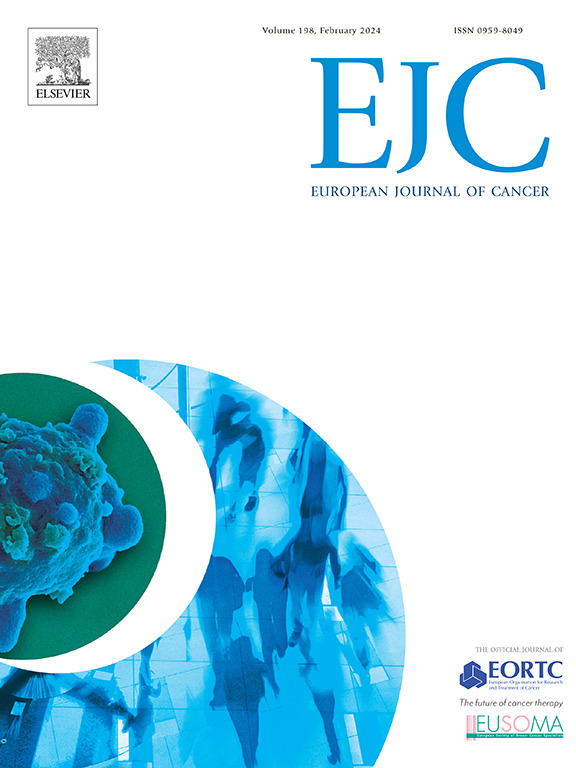[18F]FDG PET/MRI与前哨淋巴结活检对早期乳腺癌腋窝分期的影响。一项前瞻性单臂试验
IF 7.6
1区 医学
Q1 ONCOLOGY
引用次数: 0
摘要
背景:两项随机对照试验证明了早期乳腺癌患者腋部手术遗漏的非劣效性。然而,临床医生仍然犹豫放弃前哨淋巴结活检由于其潜在的治疗意义。一种可靠的淋巴结转移检测成像方法有可能取代手术。本试验前瞻性评估混合[18F]FDG PET/MRI检测早期乳腺癌女性腋窝淋巴结大转移的准确性。方法:这是一项前瞻性单臂单中心介入试验,纳入标准术前影像学无淋巴结累及且符合术前手术条件的乳腺癌患者。在2020年6月至2024年4月期间,招募的患者术前接受了[18F]FDG PET/MRI检查。两名放射科医生和两名核医学医生,都是盲的,独立地审查了这些图像。结果共纳入246例患者。5例双侧病变,共评估251个腋窝。手术时平均(SD)年龄为56.3(10.7)岁,最终病理时平均(SD)肿瘤大小为17.5 (13.0)mm。大转移性腋窝淋巴结61例(24.3% %)。[18F]FDG PET/MRI识别出43例(70.5 %),明显优于[18F]FDG PET和MRI单独识别36例(59.0 %;P = 0.016)和25(41.0 %;P <; 0.001)例。[18F]FDG PET/MRI的阴性预测值(89.4% %)高于[18F]FDG PET(86.4 %,p = 0.021)和MRI(82.9 %,p0.001 <)。解释[18F]FDG PET/MRI在临床阴性腋窝患者腋窝大转移淋巴结检出率为70.5 %,准确率高于[18F]FDG PET或MRI单独检出率。先进的影像技术可能有助于完善腋窝分期的手术策略。试验注册:临床试验。政府ID NCT04829643本文章由计算机程序翻译,如有差异,请以英文原文为准。
[18F]FDG PET/MRI vs sentinel node biopsy for axillary staging of early breast cancer patients. A prospective single-arm trial
Background
Two randomized controlled trials demonstrated the non-inferiority of axillary surgery omission in selected early breast cancer patients. However, clinicians remain hesitant to forgo sentinel lymph node biopsy due to its potential therapeutic implications. A reliable imaging modality for nodal metastases detection could potentially replace surgery. This trial prospectively evaluated the accuracy of hybrid [18F]FDG PET/MRI in detecting axillary lymph nodes macro-metastases in women with early breast cancer.
Methods
This is a prospective interventional single-arm monocentric trial including patients with breast cancer without nodal involvement on standard preoperative imaging and eligible for upfront surgery. Between June 2020 and April 2024 recruited patients underwent [18F]FDG PET/MRI before surgery. Two radiologists and two nuclear medicine physicians, all blinded, independently reviewed the images.
Findings
A total of 246 patients were included. Five had bilateral disease, leading to the evaluation of 251 axillae. Mean (SD) age at surgery was 56.3 (10.7) years and mean (SD) tumor size was 17.5 (13.0) mm at final pathology. Macro-metastatic axillary lymph nodes were found in 61 cases (24.3 %). [18F]FDG PET/MRI identified 43 (70.5 %) of these cases, and significantly outperformed both [18F]FDG PET and MRI alone, which identified 36 (59.0 %; p = 0.016) and 25 (41.0 %; p < 0.001) cases, respectively. Negative predictive value was higher for [18F]FDG PET/MRI (89.4 %) than [18F]FDG PET (86.4 %, p = 0.021) and MRI (82.9 %, p0.001 <) alone.
Interpretations
[18F]FDG PET/MRI detected 70.5 % of cases with macro-metastatic axillary lymph nodes in patients with clinically negative axilla, with greater accuracy than [18F]FDG PET or MRI alone. Advanced imaging might help refine the surgical strategy for axillary staging.
Trial registration: ClinicalTrials.Gov ID NCT04829643
求助全文
通过发布文献求助,成功后即可免费获取论文全文。
去求助
来源期刊

European Journal of Cancer
医学-肿瘤学
CiteScore
11.50
自引率
4.80%
发文量
953
审稿时长
23 days
期刊介绍:
The European Journal of Cancer (EJC) serves as a comprehensive platform integrating preclinical, digital, translational, and clinical research across the spectrum of cancer. From epidemiology, carcinogenesis, and biology to groundbreaking innovations in cancer treatment and patient care, the journal covers a wide array of topics. We publish original research, reviews, previews, editorial comments, and correspondence, fostering dialogue and advancement in the fight against cancer. Join us in our mission to drive progress and improve outcomes in cancer research and patient care.
 求助内容:
求助内容: 应助结果提醒方式:
应助结果提醒方式:


